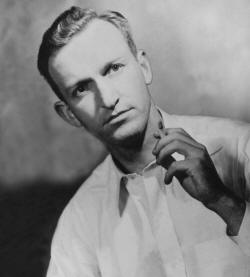

Queer Places:
Phillips Academy, 180 Main St, Andover, MA 01810, Stati Uniti
Harvard University (Ivy League), 2 Kirkland St, Cambridge, MA 02138
Holyhood Cemetery, Chestnut Hill, MA 02467, Stati Uniti
 John
Horne Burns (October 7, 1916 – August 11, 1953) was a United States writer,
the author of three novels. The first, The Gallery (1947), is his best
known work, which was very well received when published and has been reissued
several times.
John
Horne Burns (October 7, 1916 – August 11, 1953) was a United States writer,
the author of three novels. The first, The Gallery (1947), is his best
known work, which was very well received when published and has been reissued
several times.
Burns was born in 1916 in Andover, Massachusetts. He was the eldest of seven children in an upper-middle-class Irish Catholic family. He was educated by the Sisters of Notre Dame at St. Augustine's School and then Phillips Academy, where he pursued music. He attended Harvard, where he became fluent in French, German, and Italian and wrote the book for a student musical comedy in 1936.[1] In 1937 he graduated Phi Beta Kappa with a BA in English magna cum laude and became a teacher at the Loomis School in Windsor, Connecticut.[2] Burns wrote several novels while at Harvard and at Loomis, none of which he published.
He was drafted into the US Army as a private in 1942.[3] He attended the Adjutant General's School in Washington, D.C. Commissioned a second lieutenant and sent overseas in 1943, he served in military intelligence in Casablanca and Algiers and then for a year and a half in Italy, censoring prisoner-of-war mail.[2] After his discharge in 1946 he returned to teaching at Loomis.
At Loomis, he completed The Gallery, his best-known work by far, on April 23, 1946. Several publishers rejected it before Harper & Brothers published it in June 1947 and it became a best-seller.[3] It depicted life in Allied-occupied North Africa and Naples in 1944 from the perspective of several different characters. Without sentimentality, Burns explored the average man's resentment of the military, his struggle to assert his individuality within the complex war effort, the tension between officers and enlisted men, the psychological effects of dislocation, economic and social inequality between the Americans and those they defeated, the experience of homosexual military personnel, and the popular life of Naples in 1944 under the Allied occupation.[4] The title referred to the Galleria Umberto I, a shopping arcade in Naples through which several of the characters pass. The work was unconventional in structure, comprising portraits of nine characters interspersed with eight recollections narrated by an anonymous American soldier following a route much like the one Burns tracked.[3] Though largely a series of sad and painful vignettes, Burns's narrator manages a modestly positive assessment near the end: "I began to think that something good might be salvaged from the abattoir of the world. Though in the main all national decency and sense of duty might be dead, I saw much individual goodness and loveliness that reassured me."[5] In the words of Paul Fussell, "Burns relied on discontinuity, like a sort of prose T.S. Eliot, thus suggesting incoherence as a contemporary social characteristic."[6] Major newspapers and authors including Ernest Hemingway and Edmund Wilson praised it.[3] The Saturday Review called the novel "the best war book of the year".
His second novel, Lucifer with a Book, a satirical representation of life at a boarding school much like Loomis, appeared in 1949 to largely unfavorable reviews.[3] Vidal said it was "perhaps the most savagely attacked book of its day."[8] Michener wrote decades later: "Never in my memory had they come so close to total annihilation of an author's work."[13] Disheartened by the critical reception of his second novel, Burns returned to Italy in 1950, this time choosing Florence. There he wrote his last published work, A Cry of Children (1952), which was marketed as "a merciless novel" of "young love in the bohemian fringe-world".[14] Its principal character was a composer and pianist likely modeled on his Harvard classmate Irving Fine.[1] That novel also received negative press, though he remained still a young writer of promise.
He began work on a fourth novel, left unfinished at his death.[3] He supported himself by writing a long piece about the city for Holiday, one of a series he was writing for that publication on the places where he had lived, and the effort that convinced his editors they could still hope for another successful novel from him.[16]
In his time in Florence, he was known to drink to excess and complain of critics, rivals, and both friends and enemies. Vidal never saw him there: "In those years one tried not to think of Burns; it was too bitter. The best of us all had taken the worst way."[8] After a sailing trip, he lapsed into a coma and died from a cerebral hemorrhage on August 11, 1953. His parents and six siblings survived him.[2] He was buried in the family plot in Holyhood Cemetery in Brookline, Massachusetts.[17]
My published books: